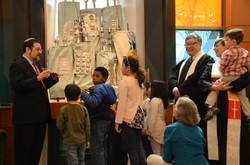Nearly a month after an electrical fire heavily damaged its sanctuary, the First Presbyterian Church of Englewood, New Jersey is still counting its blessings. The March 22nd blaze destroyed portions of the roof, stained-glass windows and the church steeple in the building which dates back to 1870.
But the damage has not stopped the congregation from growing and learning and that includes reaching out and connecting with other congregations. The church is in the middle of a three-week joint worship with Temple Sinai of Bergen County, a Reform synagogue.
“The Temple could not possibly have been more open and hospitable. Our congregation has enjoyed the new experience of worship, which is easing the pain of losing our sanctuary,” said the Rev. Richard Hong, Englewood pastor. “We are really proud of this interfaith witness. In a time when so many people view organized religion as an instigator of strife, this is an example of people of faith drawn together by love and friendship. What if the world looked a little more like this?”
In a recent service, Rabbi Jordan Millstein led the children’s sermon and opened the Torah ark, allowing children to see and touch the scrolls. Millstein drew an analogy between the gathering in their synagogue and a play date at a friend’s house.
“One of their members took a photo of our church sign indicating we would be at Temple Sinai and they were so proud to post it on Facebook,” said Hong. “Now it has been viewed nearly 10,000 times and shared widely.”
The worship collaboration has been well received, says Hong.
“It’s like a situation where you’ve always wanted to get to know a neighbor better, but never really got around to it until some exceptional circumstance forces you to, then you wish you had done it sooner,” he said.
Hong is confident the three-week joint worship will lead to future joint endeavors adding that First Presbyterian is in an area with a high concentration of Jewish families.
“Our small city of 30,000 is a model of diversity, as is our church. There is no single ethnic majority in town, which also has huge economic diversity,” said Hong. “Our church is about one third persons of color, spanning Koreans, Chinese, African-American, African, Jamaican and more. A number of members are in interfaith marriages.”
Hong says the church is committed to build for the ministry needs of the next 50 years rather than the past so every experience is helping them imagine the future.
“We had been getting larger, but now it feels like the difference between expansion and true growth,” he said. “Before we were expanding. Now we’ll truly grow. It’s just too early to know exactly what that looks like.”

